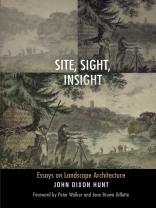Site, Sight, Insight presents twelve essays by John Dixon Hunt, the leading theorist and historian of landscape architecture. The collection’s common theme is a focus on sites, how we see them and what we derive from that looking. Acknowledging that even the most modest landscape encounter has validity, Hunt contends that the more one knows about a site and one’s own sight of it (an awareness of how one is seeing), the greater the insight. Employing the concepts, tropes, and rhetorical methods of literary analysis, he addresses the problem of how to discuss, understand, and appreciate places that are experienced through all the senses, over time and through space.
Hunt questions our intellectual and aesthetic understanding of gardens and designed landscapes and asks how these sites affect us emotionally. Do gardens have meaning? When we visit a fine garden or designed landscape, we experience a unique work of great complexity in purpose, which has been executed over a number of years—a work that, occasionally, achieves beauty. While direct experience is fundamental, Hunt demonstrates how the ways in which gardens and landscapes are communicated in word and image can be equally important. He returns frequently to a cluster of key sites and writings on which he has based much of his thinking about garden-making and its role in landscape architecture: the gardens of Rousham in Oxfordshire; Thomas Whately’s Observations on Modern Gardening (1770); William Gilpin’s dialogues on Stowe (1747); Alexander Pope’s meditation on genius loci; the Désert de Retz; Paolo Burgi’s Cardada; and the designs by Bernard Lassus and Ian Hamilton Finlay.
Inhoudsopgave
Foreword
—Peter Walker and Jane Brown Gillette
Preface
Chapter 1. The Lie of the Land
Chapter 2. Near and Far, and the Spaces in Between
Chapter 3. Stourhead Revisited and the Pursuit of Meaning in Gardens
Chapter 4. Thomas Whately’s Observations on Modern Gardening
Chapter 5. John Ruskin, Claude Lorrain, Robert Smithson, Christopher Tunnard, Nikolaus Pevsner, and Yve-Alain Bois Walked into a Bar . . .
Chapter 6. Folly in the Garden
Chapter 7. Jardins: Reflections on the Human Condition
Chapter 8. Between Garden and Landscape
Chapter 9. Ekphrasis: Déjà Vu All Over Again
Chapter 10. Preservation in the Sphere of the Mind: Duration and Memory
Chapter 11. ‘ARCH, n. an architectural term. A material curve sustained by gravity as rapture by grief’
Afterword. From Illustration to Landscape
Notes
Index
Over de auteur
John Dixon Hunt is Emeritus Professor of the History and Theory of Landscape, University of Pennsylvania. Among his numerous books are The Afterlife of Gardens and Garden and Grove: The Italian Renaissance Garden in the English Imagination, 1600-1750, both published by the University of Pennsylvania Press.












